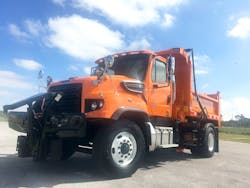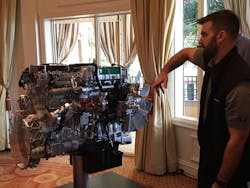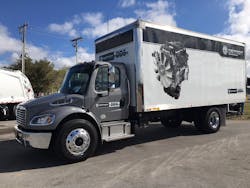DTNA: Detroit rolls out DD8 engine for vocational market
PALM BEACH, FLORIDA. Though Daimler Trucks North America (DTNA) just started production of its new Detroit DD8 engine for medium-duty and vocational markets in North America, the engine already has been tried and tested in Europe over the last several years.
During a press event here at Palm Beach, Kelly Gedert, director of product marketing, Freightliner and Detroit Components, explained DTNA has invested $375 million to bring its medium-duty engine to the NAFTA (North American Free Trade Agreement) market.
“This is not the first time this engine is being utilized,” Gedert explained. “It has been in production in Europe for five years. We already figured out some of the maneuverability issues. So we’re really excited about that. It’s a proven product already for us.”
The DD8 is the latest addition to Detroit’s powertrain portfolio, complementing the already-in-production DD5 engine. The DD8 is manufactured at Detroit’s Redford, MI, manufacturing plant, which is the same facility that produces Detroit DD13, Detroit DD15 and Detroit DD16 engines, as well as the Detroit DT12 automated manual transmission and Detroit axles.
The DD8 is a 7.7L diesel engine with power ratings ranging from 260-350 hp and 660-1050 lb.-ft. of torque. It also features:
- An optional integrated engine brake
- A variable-speed fan and advanced cooling system providing shorter fan-on times for increased fuel efficiency
- Variable cam-phasing technology for aftertreatment system performance
- 2017 Greenhouse Gas (GHG17) and 2016 Onboard Diagnostics (OBD16) compliance
- A three-year/250,000-mile warranty
- Preventive maintenance intervals of 45,000 miles
Available for Freightliner M2 106, 108SD and 114SD truck models, the DD8 engine is designed for segments such as pick-up and delivery, utility, construction, dump, mixer, plow, towing and recovery, refuse, and fire and emergency.
“The DD8 is built for performance with features that meet the needs of those specialized segments,” said Brian Daniels, manager, Detroit Powertrain and Component Product Marketing. “Additionally, a big differentiator for the Detroit brand is the Detroit Connect Virtual Technician remote diagnostics system which is available as standard on both the DD5 and DD8 engines. Virtual Technician helps fleets make informed service decisions within minutes of an engine or aftertreatment fault event, increasing uptime.”
If a truck breaks down or a fault code goes off, the Detroit Connect Virtual Technician remote diagnostics system allows fleet and service managers to can go into a portal at the back office and see what the fault code is. It also provides them the locations of the closest service shops to fix that fault code.
“This is a huge thing for the medium-duty folks who don’t have that large service network available to them,” Daniels stressed. “It gives them real-time information on the engine and aftertreatment fault codes.”
Daniels also noted that maintenance intervals for the DD8 are up to three times the standards of medium-duty engines. One of the features designed with the vocational market in mind is variable exhaust cam-phasing technology, which is used at low engine speeds to increase exhaust temperatures and increase uptime by reducing the need for manual regenerations. The DD8 also has a B10 life of 400,000 miles, which means that 90% of the engines produced will go beyond 400,000 miles before they need to be overhauled.
“What that means to a vocational customer – the average vocational usage is 10,000 miles a year, maybe as high as 30,000 miles a year – is that 400,000 miles is essentially the life of that vehicle,” Daniels added.
Daniels also noted that one of the big challenges for a vocational customer is to have an aftertreatment system (ATS) in which the customer’s vehicle body will mount on Detroit’s chassis with as limited interference as possible.
“The worst thing we could do to an end user or manufacturer is give them an aftertreatment that forces their body to go a foot or two back on that truck,” he explained. “That means a less efficient design and less space for them to put what they need on the truck.”
Going forward, Gedert said additions to the DD8 will be rolled out in phases, and the DD5, which had a quick launch in 2016, will be relaunched in the fourth quarter of 2018.
About the Author

Cristina Commendatore
Cristina Commendatore is a past FleetOwner editor-in-chief. She wrote for the publication from 2015 to 2023.


